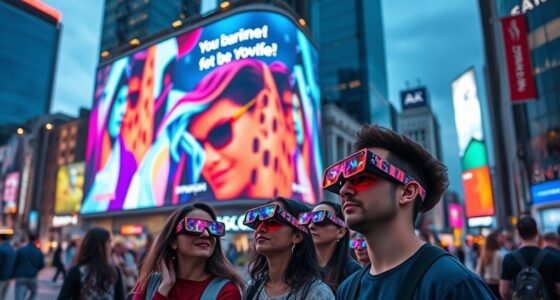By combining 3D motion and immersive visuals, you create experiences that are visually deep and fluid, making environments feel more real and engaging. Techniques like perspective shifts, smooth movement, and layered visuals help maximize spatial awareness. Adding sensory cues like sound, vibration, or scent enhances the realism, making interactions feel natural and emotionally impactful. If you keep exploring, you’ll discover how these methods can transform your digital worlds into enthralling, multisensory experiences.
Key Takeaways
- Integrate real-time scene responses with 3D motion to enhance depth perception and user immersion.
- Use layered visuals and perspective shifts to mimic real-world spatial awareness.
- Combine multisensory cues—sound, vibration, scent—for a multi-dimensional experience.
- Employ smooth, dynamic motion graphics that guide the viewer’s eye and emphasize movement.
- Incorporate interactive storytelling that responds to user actions, deepening engagement and realism.

Have you ever wondered how modern visuals draw you so convincingly into their worlds? The secret lies in the seamless blend of 3D motion and immersive visuals, which create a sense of depth and movement that feels almost real. When you experience these visuals, you’re not just watching images on a screen; you’re entering a world where every element responds dynamically to your presence. This is achieved through advanced techniques like interactive storytelling, which actively involves you in the narrative, and sensory engagement, which stimulates multiple senses to deepen immersion.
In these environments, you don’t passively observe; you participate. Interactive storytelling transforms passive watching into active involvement, allowing you to make choices that influence the story’s progression. This interaction heightens your sense of presence, making the experience personalized and compelling. As your actions trigger visual changes, the scene responds in real-time, emphasizing the depth and movement within the virtual space. The more you engage, the more convincing the illusion becomes, blurring the line between the digital and real worlds.
Sensory engagement plays a fundamental role in amplifying this realism. Beyond visuals, developers incorporate sound, haptic feedback, and even scent to enhance your connection to the environment. For example, when a virtual object moves closer, you might hear rustling sounds or feel a slight vibration, reinforcing the sensation that you’re truly part of the scene. These multisensory cues work together to create a layered experience that immerses you fully, encouraging you to explore and interact more naturally within the digital landscape.
Sensory cues like sound, vibration, and scent deepen immersion, making virtual experiences feel truly alive.
The depth in these visuals isn’t just about perspective; it’s about layering information and creating a three-dimensional space that your mind can interpret intuitively. With motion graphics that flow smoothly and perspective shifts that mimic real-world physics, you get a sense of spatial awareness that heightens realism. This sense of movement guides your eye through the scene, making the experience feel fluid and alive. As you navigate through these environments, you quickly realize that the visuals aren’t static images but dynamic worlds that respond intelligently to your presence.
Ultimately, the combination of 3D motion and immersive visuals isn’t just about spectacle; it’s about crafting experiences that resonate on a sensory level. By integrating interactive storytelling and sensory engagement, creators build environments that are not only visually stunning but emotionally compelling. You’re no longer a mere observer—you become a participant, fully immersed in a multidimensional world that feels as vivid and alive as the real one.
Frequently Asked Questions
How Does 3D Motion Impact User Experience in Virtual Environments?
3D motion profoundly enhances your experience in virtual environments by increasing perceived realism, making scenes feel more authentic. When movement and depth are well-implemented, you’re more likely to feel emotionally engaged because the environment responds naturally to your actions. This seamless interaction draws you deeper into the virtual world, creating a mesmerizing experience where you feel more connected and immersed, ultimately making the virtual environment feel truly alive.
What Hardware Is Essential for Immersive 3D Visuals?
To experience immersive 3D visuals, you need a high-quality VR headset with eye tracking and haptic feedback. Eye tracking enhances realism and interaction, while haptic feedback provides tactile sensations for more immersive engagement. A powerful graphics card and enough RAM are also essential to render detailed visuals smoothly. Together, these hardware components create a seamless, realistic virtual environment that fully immerses you in the experience.
Can 3D Motion Technology Reduce Motion Sickness?
Think of 3D motion technology as a soothing balm for your senses. It can indeed reduce motion sickness by enhancing visual comfort, making movements smoother and more natural. When your brain better understands the visual cues, you’re less likely to feel disoriented. By tailoring motion algorithms, designers can minimize discomfort, ensuring immersive experiences are enjoyable rather than dizzying. So, yes, 3D motion tech can turn chaos into calm for your eyes.
How Are Depth Cues Enhanced in Immersive Visuals?
You enhance visual depth by leveraging cues like perspective, shading, and motion parallax, which improve your depth perception. These immersive visuals use stereoscopic displays to create a sense of visual depth, making objects appear more three-dimensional and lifelike. As a result, your brain interprets the scene with greater accuracy, increasing realism and reducing discomfort, while allowing you to experience a more engaging and convincing virtual environment.
What Are the Future Trends in 3D Motion and Immersive Displays?
You’ll see future trends in 3D motion and immersive displays focus on integrating augmented reality and holographic displays. Expect more seamless blending of digital and real worlds, enabling interactive experiences that feel incredibly lifelike. Advances will include lightweight, portable holographic tech and smarter AR systems that adapt to your environment in real time. These innovations will make immersive visuals more accessible, engaging, and immersive, transforming entertainment, education, and communication.
Conclusion
By merging 3D motion with immersive visuals, you create experiences that truly captivate your audience. Imagine a virtual museum tour where visitors feel like they’re walking through ancient ruins, thanks to realistic depth and movement. This combination not only enhances engagement but also deepens understanding. As technology advances, your ability to craft such compelling experiences grows, making immersive visuals an essential tool for innovative storytelling and education. Embrace the depth and motion to transform how people see and interact with digital worlds.









